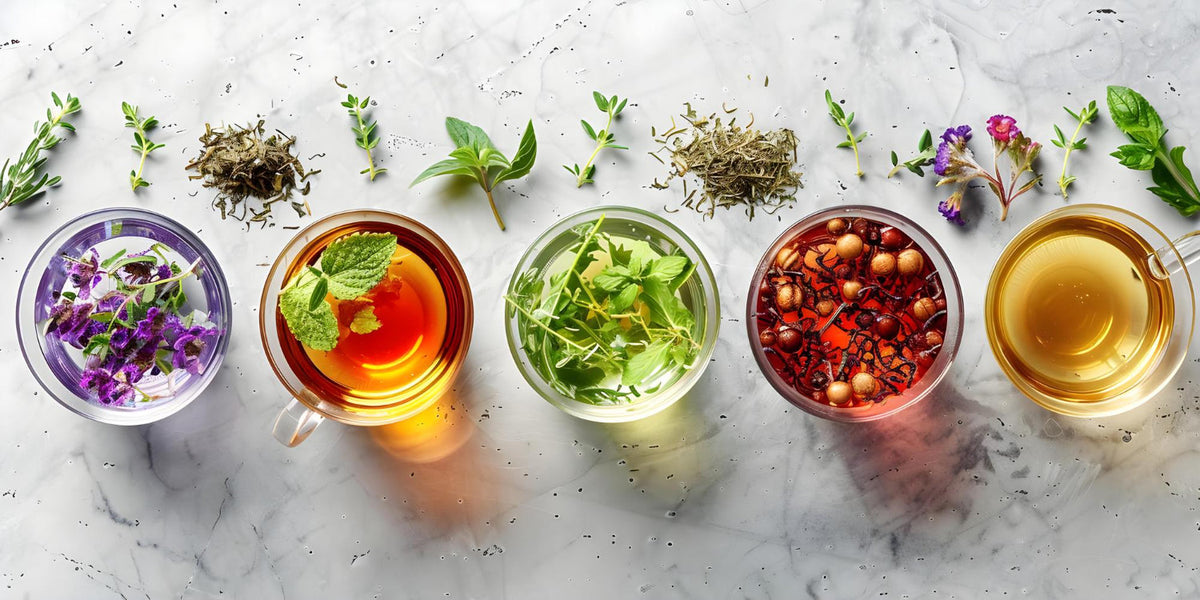Best Energising Herbal Teas with Low or No Caffeine

Morning energy shouldn’t feel like a bargain with jitters and a 2pm crash. If coffee has you wired, or your adrenals are sounding the stress alarms, energising herbal teas offer clean alertness with calmer physiology. Some plants (like yerba mate) deliver a smoother stimulant profile; others (ginger, rooibos, lemongrass, tulsi) create lift via circulation, hydration, mineral support, and reduced stress reactivity. The result is steady focus, not false fireworks. In this guide, I map how energising herbs work, when to drink them, and which blends are worth your money—then showcase three sales-proven picks you’ll actually enjoy daily. Pick a flavour you love, build a small ritual, and your energy will follow discipline—not adrenaline.
Why switch from coffee to energising herbal tea?
Caffeine is fast, but not always friendly. Many people tolerate one strong cup; the second pushes heart rate, flares reflux, blunts appetite, and quietly shoves the nervous system into fight-or-flight. If your mornings start hot and hurried, your “energy problem” may be less about stimulation and more about stress and hydration. Herbal teas approach alertness from multiple angles: they reduce the load (ease gut tension and anxiety), improve inputs (fluid, minerals, polyphenols), and enhance flow (better circulation and gastric emptying). Clean energy is what remains when friction drops.
Three practical advantages matter for real-world routines. First, dosage: a bag in a mug is consistent—no “one scoop too much.” Second, behaviour: a warm cup slows you down long enough for your frontal cortex to take the wheel; you make calmer decisions and then have less to recover from. Third, enjoyment: flavour drives adherence. A tea you like is a habit you keep, which is how small physiology shifts add up to notable change in mood and productivity.
Low-caffeine vs zero-caffeine: choose by physiology, not hype
“Energising” doesn’t have to mean caffeinated. Plants create alertness through different mechanisms:
- Smooth stimulants (low caffeine): Yerba mate blends caffeine with theobromine for gentler cardiovascular impact and steadier mood.
- Stress modulators (no caffeine): Tulsi, lemon balm, ashwagandha reduce cortisol spikes so your baseline energy feels available again.
- Circulatory & digestive lifts (no caffeine): Ginger, lemongrass, peppermint improve oxygenation, gastric emptying, and bloating—less drag equals more drive.
- Mineral & antioxidant supports (no caffeine): Rooibos, hibiscus aid hydration and recovery, creating even energy across the day.
Plant profiles: how our favourite energisers actually work
Yerba Mate — smooth focus with fewer jitters (low caffeine)
Yerba mate (Ilex paraguariensis) is the coffee alternative that actually behaves like a teammate. It contains moderate caffeine (less than coffee), plus theobromine—the cacao compound that widens blood vessels and contributes to a steadier, more expansive alertness. Polyphenols (chlorogenic acids) further modulate glucose availability and oxidative stress. Subjectively, mate drinkers describe an “open-eyed calm” rather than a spiky buzz. That makes it useful for deep work, lectures, or long drives—situations where you want focus without heart-noise.
Your practical rules: keep it earlier in the day, sip rather than slam, and pair with a light protein snack to flatten any glycaemic dip. Bags are gentler than bombilla gourds; they also make dosage repeatable. If you’re stepping down from double espresso, mate is a smart bridge—alert, social, and satisfying—but respect your 2pm cut-off so sleep architecture stays clean.
Try: Planet Organic Yerba Mate (25 bags) .
Ginger + Lemongrass — circulation first, clarity follows (no caffeine)
When “low energy” is really low circulation (cold hands, sluggish gut, heavy head after lunch), warming herbs beat stimulants. Ginger contains gingerols and shogaols that support gastric emptying and peripheral blood flow, alleviating the post-meal fog caused by slow digestion. Lemongrass adds citral-rich aromatics that feel bright, clean, and mentally directive—like opening a window in your head. Together they create lift without any push; you feel tidy rather than turbo.
Clinically, I recommend this duo as an 11am or 3pm reset: drink a cup, stretch your hips, and go outside for light. The ritual shifts you back to parasympathetic balance—the state where creative focus is easiest. Ginger also supports joint comfort and nausea control, making it a clever travel companion.
Try: Yogi Ginger Herbal Tea — warming, spicy, and caffeine-free.
Rooibos — mineral-rich calm focus (no caffeine)
Rooibos (Aspalathus linearis) is naturally caffeine-free and unusually high in minerals (magnesium, zinc) and polyphenols (aspalathin, nothofagin). That combination supports hydration, mitochondrial housekeeping, and stress resilience. Don’t expect a jolt; expect steadiness. Many users notice improved mid-afternoon productivity and fewer evening snack cravings when they swap soft drink for iced rooibos. Green rooibos is lighter and more grassy; red rooibos is rounder and vanilla-friendly.
Tip: Brew a strong pot in the morning; pour over ice with lemon for a zero-caffeine workplace drink.
Tulsi (Holy Basil) — stress down, energy available (no caffeine)
When stress hogs energy, you don’t need more throttle—you need less braking. Tulsi (Ocimum sanctum) is an adaptogenic leaf with rosmarinic acid and eugenol that modulate cortisol dynamics and support cognitive flexibility. The subjective feel is “unclenched but clear.” It stacks beautifully with lemon balm or green rooibos for workday composure. Use tulsi when your brain is busy but unproductive.
Pair with: Ginger (morning) or chamomile (evening) to book-end your stress curve.
Quick comparison: find your energiser
| Herb/Blend | Caffeine | Key actives | Feel | Best for | When to drink | Example |
|---|---|---|---|---|---|---|
| Yerba Mate | Low | Caffeine + theobromine, chlorogenic acids | Smooth focus; social alertness | Replacing extra coffee; study blocks | Morning; avoid after 2pm | Planet Organic Yerba Mate |
| Ginger + Lemongrass | None | Gingerols, shogaols, citral | Warm, clear, de-fogging | Afternoon slump; travel digestion | Late morning or mid-afternoon | Yogi Ginger |
| Rooibos (red/green) | None | Aspalathin, minerals (Mg, Zn) | Calm focus; hydration support | Caffeine-sensitive; evening work | Anytime; great iced | Planet Organic Rooibos |
| Tulsi (Holy Basil) | None | Rosmarinic acid, eugenol | Unclenched clarity | Stress-heavy mornings, meetings | Morning–early afternoon | Tulsi blends |
Timing, dosing, and pairing: make energy repeatable
- Timing: Mate on waking or mid-morning; ginger/lemongrass at 11am or 3pm; tulsi or rooibos anytime.
- Dose: 1 bag per 250–300 ml; steep 5–8 minutes covered to capture aromatics.
- Hydration stack: One energising tea for every coffee you remove; 2–3 cups/day is a sweet spot.
- Food pairing: Add a light protein snack with mate; pair ginger with a walk for maximal lift.
- Sleep protection: Keep any stimulant (even mild) away from the last 8 hours of your sleep window.
Eco Traders Picks: Clean Energy, Zero Crash

Yogi — Ginger Herbal Tea (16 bags)
- Gingerols support gastric emptying & warm the system.
- Clean, spicy cup that replaces a “second coffee.”
- Great travel ally for nausea and motion days.

Pukka — Morning Berry (20 bags)
- Fruity lift without stimulant spikes.
- Excellent iced; supports hydration first thing.
- Kid-friendly flavour; easy household upgrade.

Planet Organic — Yerba Mate (25 bags)
- Smoother than coffee; social and steady.
- Great bridge for reducing espresso intake.
- Keep before 2pm to protect sleep quality.
Shop herbal energy by brand
The bottom line: reduce friction, then add flavour
Most “energy issues” are actually friction issues: tension, indigestion, dehydration, or cortisol noise. The fastest path back to good energy is subtractive—less friction—before you add stimulation. Energising herbal teas do both. Ginger and lemongrass tidy digestion and circulation. Rooibos hydrates and stabilises. Tulsi lowers the body’s background alarm so your baseline capacity returns. If you still want a little push, mate provides it in a kinder key.
Start with your use-case. Need a morning lift without chaos? Brew mate and eat a protein snack. Mid-afternoon fog? Ginger, lemongrass, or rooibos on ice. Meeting-heavy day? Tulsi for “calm focus.” Guard your sleep by keeping any stimulant away from the last eight hours of your night. Finally, protect adherence with flavour you love. Pick one blend for weekday mornings and one for afternoons. In two weeks, you won’t miss your second coffee—you’ll miss your tea ritual.
Ready to stock a smarter energy shelf? Shop Tea & Infusions
Frequently Asked Questions
Which herbal tea gives energy without caffeine?
Ginger, lemongrass, rooibos, and tulsi lift energy by improving circulation, hydration, and stress balance—no caffeine required.
Is yerba mate better than coffee for focus?
Mate contains less caffeine plus theobromine for smoother alertness and fewer jitters. Keep it to mornings to protect sleep.
What tea is best for the afternoon slump?
Ginger or lemongrass resets circulation and digestion; rooibos supports hydration. All are caffeine-free and evening-safe.
Can herbal tea replace my second coffee?
Yes. Use mate before 2pm for a gentle push, or choose ginger/rooibos for calm energy without any stimulant.
How many cups of energising herbal tea can I drink daily?
Two to three cups suits most adults. If using mate, limit to one cup and avoid late intake.
Does ginger tea actually boost energy?
Indirectly, yes—ginger improves gastric emptying and blood flow, reducing post-meal fog and helping you feel alert.
What’s the best caffeine-free tea for productivity?
Tulsi (holy basil) promotes clear, calm focus by modulating cortisol. Pair with lemon balm for busy days.
Are energising herbal teas safe every day?
Generally yes. Choose organic brands, rotate blends, and consult your GP if pregnant, on medication, or managing chronic conditions.
Do herbal teas dehydrate me?
No—caffeine-free herbal teas count toward fluid intake and often improve electrolytic balance compared with coffee.
Where can I buy these teas in Australia?
Shop our curated range at Eco Traders: Tea & Infusions.
About this article
No citations provided.
-
16 October 2025Notes:Article published


